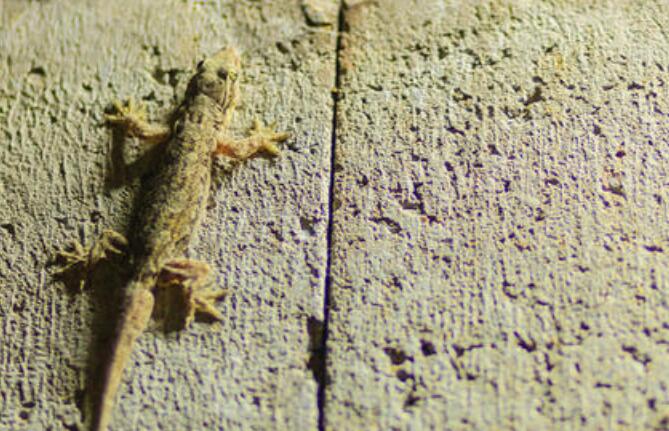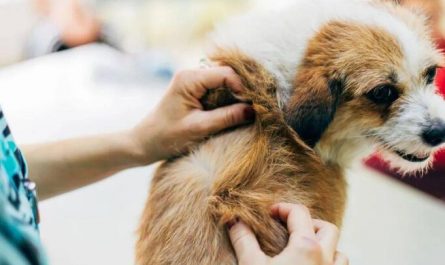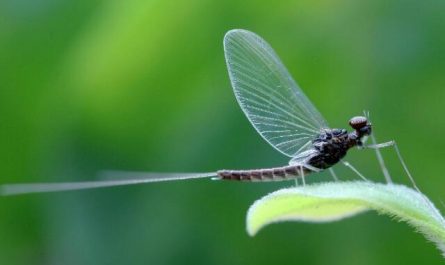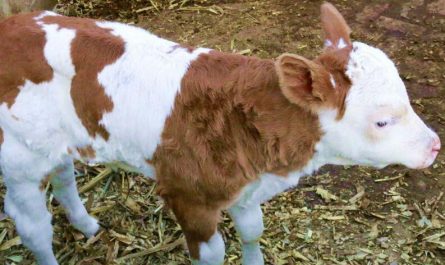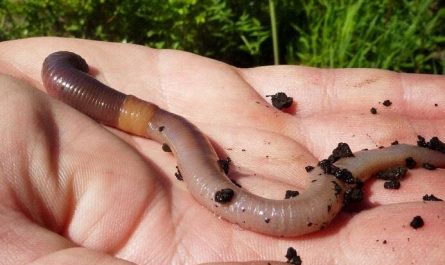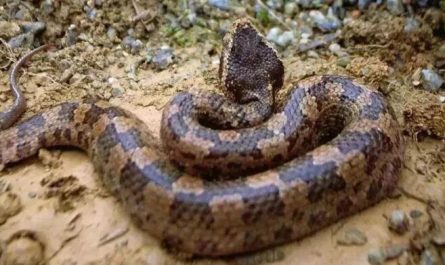Why the lizard won’t fall
There are many types of lizards and they live in a wide range, almost all over the world. Their crawling method is also very peculiar, can crawl on the ceiling without falling off. There have been various explanations for this. Some believe that this is because they can secrete a kind of mucus on their limbs; others believe that these lizards have suckers on their feet, and they crawl on the ceiling with the help of suckers.
With the help of electron microscopes, recent studies have shown that there are 1.5 million small spicules per square millimeter on the epidermis above the toes of lizards. Each small spicule is thick and densely branched repeatedly into hundreds of spoon-shaped protrusions. The lizard relies on the spoon-shaped protrusions on these small spicules to increase the friction between the toes and the ceiling, so that their body will not fall off.
Among animals like lizards, geckos are the best at crawling on the ceiling. A gecko’s four-legged foot has an enlarged soft cushion, which is composed of many slabs. These slabs are actually scales covered by millions of microvilli. The diameter of this microvilli is only 10 microns. It is 90 microns long and has a hook shape. The dense micro-hooks can help the gecko easily grasp the tiny bumps on the ceiling, so that it can walk on the ground without falling.
Life habits of lizards
Most of the species are carnivorous, feeding on insects, earthworms, snails, and even mice. But there are also cactus or seaweed as the main food, or omnivorous.
Most lizards feed on insects and some rodents, and occasionally eat poultry. They have sharp teeth with three cusps. The crowns of herbivores (such as iguanas) are wide, leaf-shaped, with serrated margins. Those who feed on mollusks and crustaceans (such as the Kaimen lizard [Dracaena]) have blunt teeth on the back of their palate for crushing. The Gila monster in the southwestern United States and its Mexican relatives (Heloderma) are poisonous. They bite when irritated, but are rarely fatal. They have longitudinal grooves or folds on the inside of each tooth in their lower palate to elicit venom. The teeth of most lizards are born on the upper palate, anterior palate and the edge of the dental bone, and a few species are born on the palate. There are “egg teeth” on the palatine bone before the embryonic stage, which protrude forward from the muzzle and are used to drill through the egg shell, which degenerate after hatching. The way of tooth implantation is mostly lateral, and some of them are terminal. The eyes of refuge can move independently. Many lizards have salt glands to excrete mineral salts. The shoulder straps are present.
Lizards live in different habitats, living underground, on the surface or in tall vegetation, and can be seen in deserts and islands. The only remaining marine species is the marine iguana of Galapagos Islands, which eats seaweed. There are several species of lizards that are partially aquatic and feed on freshwater creatures. The most important environmental factor for lizards is temperature. Many species have their “optimal temperature”, which increases their body temperature by basking in the sun to make it higher than the temperature. Species that live in cold regions hibernate. Day length also affects lizards. Most lizards are oviparous, and their eggs lay in burrows dug, in cracks in trees, rocks, or under layers of fallen leaves. Some lizards (especially those living in high altitudes and high latitudes) are ovoviviparous or viviparous. Many have no habit of protecting eggs, but Eumeces fasciatus stays by the egg during incubation. A few species (such as Lacerta and Cnemidophorus) have parthenogenesis. The cloacal anal hole is located on the ventral surface of the tail base and is the boundary between the tail and the trunk. The parthenogenesis of the latter is a hybrid of two bisexual species. Many geckos lay their eggs in the same place. The Gila monster lizard can live up to 25 years and the gecko can live up to 20 years.
Most lizards are active during the day, and geckos are mostly active between dusk and dawn, and can make loud noises (and most lizards cannot make sounds). The predation method of lizards is waiting or searching. Many lizards can cut their tails, and the broken tails can be twisted quickly to distract predators, and lizards can escape. Many lizards have domain behaviors (including domain performances) or courtship performances. Many species have femoral holes that may be used to secrete chemicals to attract the opposite sex. Lizards are of little economic significance to people. Some iguanas are edible, and some can be tanned. Geckos live in the house and can catch pests, but they may spread Salmonella. Lizard is an important research material in biology, and it is often fed as a play animal.
Active feeding
Lizards are temperature-changing animals. Lizards living in temperate and frigid zones enter a dormant state in winter, showing changes in seasonal activities. Lizards living in the tropics can be active all year round due to the warm climate. But in particularly hot and dry places, there is also summer dormancy to survive the harsh environment of high temperature and dryness and lack of food. It can be divided into three types: daytime activities, night activities, and twilight activities. The formation of different types of activities mainly depends on the activity habits of the food objects and other factors.
The range of individual lizards is very limited. Arboreal lizards often only move between a few trees. According to the research of several lizards that move on the ground, such as the southern lizard, the average range of activity is about 1,000 square meters. Some types also show differences in age. The newly hatched Sphenomorplus mostly live near the waters of the hatching area, and then move to the distant forest to move as an adult.
Most lizards eat animal food, mainly insects. Gekkonids live at night and feed on insects such as Lepidoptera. Larger lizards such as gecko (gekkogecko) can also be small birds, and other lizards are food. Varanus can eat fish, frogs and even small mammals. There are also some lizards such as the iguana (Agama) for plant food. Since most species eat a lot of insects, the role of lizards in controlling pests cannot be underestimated. Many people think that lizards are poisonous animals. This is wrong. Among the 6000 species of lizards in the world, only two venomous lizards are known. They belong to Helodermatidae and are distributed in North and Central America.
The appearance characteristics of lizards
Lizards are the most diverse group of reptiles (reptiles). More than 4,000 species are known in the world, mainly distributed in the tropics. The size varies greatly, from the Caribbean gecko, which is a few centimeters, to the Komodo dragon, which is nearly 3 to 5 meters long.
The feet of some species called snake lizards have degenerated, leaving only a few traces of the feet. They can be distinguished from snakes because they have eyelids and ears.
Many lizards can change their color in response to environmental changes or stress, such as chameleons.
Sauria reptiles (reptiles) collectively. The Serpentes, which are closely related, together account for 95% of the existing reptiles. It is divided into 18 sections and more than 3,000 species. The tropical regions have the most types and numbers. It is distributed from the Arctic to southern Africa, South America and Australia. The body shape and size of lizards differ the most among reptiles. The body length ranges from 3 cm (1 inch, gecko) to 3 meters (10 feet, monitor lizard). The lightest person is less than 1 gram, and the heaviest person is more than 150 kg. The body is mostly slender, with a long tail and four limbs. Except for the nostrils, mouth, eyes and cloaca openings, the body is covered with scales, a pair of eyes and a pair of ear holes. If there is no external ear hole, the tympanic membrane is located on the surface, and some species have bone scales in the dermis under the head and body scales. The surface of the scales is covered with a layer of keratin. Some lizards have scale organs, with jagged edges of scales protruding from bristles, which may be tactile. Many lizards, especially refuge (chameleon) and anole lizards, can change their body color, from bright green to dark chocolate brown, and their upper body lines and markings can also appear and disappear. The discoloration mechanism is the movement of pigment particles in melanocytes. The color is light when the particles are concentrated and dark when they are dispersed. Some lizards have stretchable skin folds on their necks, horns or helmets on their heads, or spines or wrinkles on their throats. The front part of the skull is composed of thin cartilage and membranes. The eyelids are mostly movable. The two eyes are separated by a thin vertical orbital space. There is a temporal hole on the bone rod formed by the posterior orbital bone and the squamous bone. The upper palate can move relative to the other parts of the skull. It has square bones and its mouth can be opened to facilitate swallowing of prey.
Most lizards have four legs and powerful hindlimb muscles. They can run quickly and change the direction of running quickly. Cnemidophorus belongs to the genus Cnemidophorus at a speed of 24 kilometers (15 miles) per hour. Several families of lizards have elongated bodies, shortened limbs, or even no limbs. Geckos, Uta and Acanthodactylus have multiple borders on their toes to increase their surface area and prevent sinking into the sand. Geckos can crawl on vertical glass panels. Each foot has 5 toes, which are divided into two groups by skin webs. The 3 toes on the outer side and 2 toes on the inner side of the hind limbs form a group. On the contrary, the male body has a pair of transfer organs-semi-penis. The king lizard can run over short distances of water.
